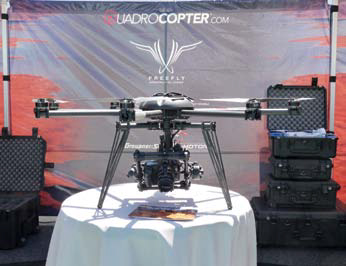Drones Are Still Up in the Air

Tom Butts
Editor-in-Chief
tbutts@nbmedia.com
As broadcasters, sometimes it’s just as important to be in the air as on the air. Whether we’re capturing breaking news, covering a sporting event or providing live traffic reports, we spend a lot of time literally flying around. Our obsession with air coverage was even a key story angle to “Anchorman 2,” as the film pondered how news networks got caught up in the hysteria of covering car chases by air back in the ’80s, and how this obsession subsequently trivialized the news.
What isn’t trivial, however, is the inherent danger involved in operating aircraft on a day-to-day basis, as we were reminded by last month’s helicopter tragedy in Seattle. Former longtime KOMO-TV News photographer Bill Strothman and pilot Gary Pfitzner were killed when their helicopter crashed. The accident struck a nerve in the community; for many citizens, broadcasters occupy a special role in keeping communities safe and informed. “These people and what they do are such a big part of our lives,” read one online post. “They help define this whole area.” Our sincere condolences go out to the families and friends of the victims and to the staff at KOMO-TV.
Our industry is not without its risks and probably never will be, but an obvious response to the dangers of air coverage is, of course, the drone. Drones have been on the drawing boards of a number of broadcasters and broadcast vendors for several years now. You couldn’t miss seeing or hearing them in the Central Hall at this year’s NAB Show—all promoting an activity that is, in essence, still mostly illegal in the United States.

Ready to fly By now we’ve all heard of the potential of drones, from providing aerial news coverage and emergency response to postal services (Amazon) and perpetual Internet coverage, i.e. Google’s recent acquisition of Titan Aerospace to deliver Internet access to remote areas. Some broadcasters used drones to cover the Winter Olympics in Sochi.
The cost of drones, compared to a helicopter, and their ease of use make for a tempting market for broadcasters, but it could be a long wait before the rules are written. The FAA has stated that it doesn’t expect to meet its 2015 deadline. The agency will hold its first public hearing on the subject in Washington this month.
But the “buzz”—both literally and figuratively— that these devices made at the NAB Show is proof enough that we could soon see a viable and safer alternative for providing aerial news coverage to our viewers. And we can hope that the type of tragedy that occurred in Seattle will become ever rarer.
Get the TV Tech Newsletter
The professional video industry's #1 source for news, trends and product and tech information. Sign up below.
Tom has covered the broadcast technology market for the past 25 years, including three years handling member communications for the National Association of Broadcasters followed by a year as editor of Video Technology News and DTV Business executive newsletters for Phillips Publishing. In 1999 he launched digitalbroadcasting.com for internet B2B portal Verticalnet. He is also a charter member of the CTA's Academy of Digital TV Pioneers. Since 2001, he has been editor-in-chief of TV Tech (www.tvtech.com), the leading source of news and information on broadcast and related media technology and is a frequent contributor and moderator to the brand’s Tech Leadership events.

